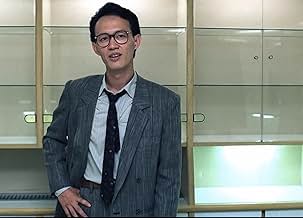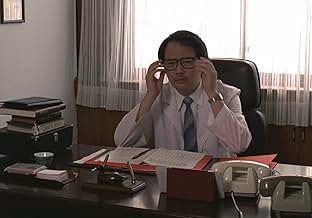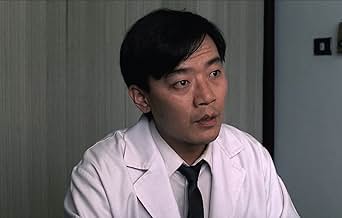Kong bu fen zi
- 1986
- 1h 49min
CALIFICACIÓN DE IMDb
7.7/10
5.9 k
TU CALIFICACIÓN
Un misterio metafísico sobre la vida de tres parejas en Taipei que se cruzan continuamente durante un lapso de varias semanas.Un misterio metafísico sobre la vida de tres parejas en Taipei que se cruzan continuamente durante un lapso de varias semanas.Un misterio metafísico sobre la vida de tres parejas en Taipei que se cruzan continuamente durante un lapso de varias semanas.
- Dirección
- Guionistas
- Elenco
- Premios
- 4 premios ganados y 2 nominaciones en total
Li-Chun Lee
- Li Lizhong
- (as Lichun Lee)
Yu An-Shun
- Da Shun
- (as An-Shun Yu)
- Dirección
- Guionistas
- Todo el elenco y el equipo
- Producción, taquilla y más en IMDbPro
Opiniones destacadas
After ho-hum reactions to YI YI and BRIGHTER SUMMER DAY, this is the first Yang movie that I liked. The interwoven plot threads slowly reveal themselves in pieces, culminating in a finale that pulls everything together and yet opens up new mysteries. There is some fine cinematography, and the themes of alienation and disconnectedness give you something to chew on. However, I really can only appreciate this on an intellectual level. For me to really love a movie, I have to have some kind of emotional reaction to it. It has to be touching, or amusing, or exciting, or frightening. Like a lot of Antonioni (whose name repeatedly pops up in the reviews of this film), it only left me cold. Only one scene (when the writer weeps in her confused husband's embrace) had any kind of emotional resonance with me. I don't mind a film that makes you think, but there has to be something else to hook me in and encourage me to give it thought. For those who love cinema on a more intellectual level, however, I imagine this would be more rewarding.
This film is shot entirely in Taipei, Taiwan, which in every film I've seen where it is a "co-star" is an interesting city. This film shows Taipei as gritty, dirty, ugly, poor and indifferent. The film was released in 1986 and it follows the police and ordinary citizens in situations which mirror everyday life, including shootouts and chaos. The first scene is a police siren and soon you see a dead man lying on the street. Scenes here are interwoven amongst the characters, who at first seem like they don't inhabit the same world. This makes the film kind of fascinating, that you're a fly on the wall in these people's lives. The use of stark imagery, shadows and light is very effective. The film, despite its title, is not about terrorism or the violence of a particular person. There are lies told in this film which cause some of the problems faced by the main characters. If you do not like moody, introspective films, I don't recommend this. However, director Edward Yang (whom we lost in 2007) has a very impressive body of work (you have to see "Yi Yi") and this is an impressive film.
Edward Yang is one of the few filmmakers who can made the present-day seem like a dystopia. He is often compared to Antonioni: this is his 'Blow-up' - an ascetically formal, fragmented murder mystery stumbled on by a photographer. In his use of dream narrative and a character who writes a mystery novel, Yang goes beyond the Italian in narrative obscurity. 'The Terroriser' shares many themes with his more accessible masterpieces 'A Brighter Summer Day' and 'Yi-Yi' - the alienation of capitalist, urban life; the alienation of relationships and aimlessness of youth; the mind-numbing compromises and betrayals in the workplace - but in a framework that coldly precludes identification.
It is unlikely that Edward Yang would quarrel with those who described him as the Antonioni of the East. But this kind of comparison is perhaps more damaging than helpful since it only engenders perceptions that have little or nothing to do with the filmmaker. If we are to understand Yang at all, we must allow his works to speak for themselves--they must succeed or fail on their own terms. "The Terrorizer" is one of Edward Yang's most accomplished works. In style, concerns, and methodology it differs significantly from the masterworks of Antonioni. Whereas Antonioni prefers to work with a narrower canvas, choosing to develop his characters until they achieve self-awareness, Yang seems to eschew such conventions, offering instead a logic akin to the dream world. "The Terrorizer" is indeed constructed very much like Chuang-Tzu's tale about a man who is unsure if he was dreaming that he was a butterfly or a butterfly who was dreaming that he was a man.
It would be a disservice to think that the ending of The Terrorizer is anything like O. Henry. It is perhaps more accurate to describe the ending as a faux denouement. The use of not a single but a double dream suggests that Yang is fully aware of his Chinese roots even when he is consciously quoting an outsider like Antonioni. It also indicates that he is less interested in the psychology of social behavior than in the actions taken by individuals and the effects they have on one another throughout the social network, regardless of their relations to each other. It is to this end that several couples in an unnamed metropolis of Taiwan are examined: a photographer and his girlfriend living off the wealth of their family; a teenage hustler and her pimp on a downward spiral of crime; an unhappily married novelist who embarks on an affair with a past lover. These three couples, in turn, are connected in some way, tangibly or peripherally, to a policeman, a law enforcer who is powerless to hold the city together, to keep it from coming apart. It is little wonder that everyone is constantly forging new relationships or alliances in a city where obsolescence is the rule.
Just as Antonioni uses dislocation as a means of conveying alienation, Yang chooses to use absentation--the absence of things--as a thematic device. Throughout the narrative one is reminded of the absence of fathers--both socially and politically. It is the absence of leadership. Elsewhere, absentation is employed when the photographer decides to turn an apartment into one huge darkroom which denies him the reality of time while permitting him to create a world of his own. At one point, a teenage girl whom he temporarily harbors asked him if it is day or night. When the camera finally peeps outside the apartment Yang gives us neither day nor night but that brief moment in time when light gives way to darkness or darkness breaks into light. It is here that Yang best captures the logic of that dream world: his protagonists are merely phantoms suspended in time. It is the absence of time. Throughout the narrative one is sometimes puzzled by the seemingly lack of explanations: the initial breakup of the photographer and his girlfriend (witnessed over the soundtrack of "Smoke Gets in Your Eye"); the return of the photographer's stolen cameras; the breakup of the married couple; the status of the policeman with no emotional or physical ties. It is the absence of elucidation. Unlike the works of Antonioni where there is always a central character whose viewpoint mirrors our own, functioning as a filter of reality, Yang denies us of such privilege. The impossibility of identifying with any character may be disorientating but it also serves as a metaphor of a city that has lost its moral compass. It is the absence of a central viewpoint. Absentation is clearly an effective tool in exploring the void that lies at the heart of modern culture--it is the black hole of the human condition.
When the film finally concludes it matters little what portion of it is real or a dream. Or for that matter who the dreamer really is. Fiction is perhaps no more than merely dreams, perfectly realized, and cinema the greatest dream machine ever built.
It would be a disservice to think that the ending of The Terrorizer is anything like O. Henry. It is perhaps more accurate to describe the ending as a faux denouement. The use of not a single but a double dream suggests that Yang is fully aware of his Chinese roots even when he is consciously quoting an outsider like Antonioni. It also indicates that he is less interested in the psychology of social behavior than in the actions taken by individuals and the effects they have on one another throughout the social network, regardless of their relations to each other. It is to this end that several couples in an unnamed metropolis of Taiwan are examined: a photographer and his girlfriend living off the wealth of their family; a teenage hustler and her pimp on a downward spiral of crime; an unhappily married novelist who embarks on an affair with a past lover. These three couples, in turn, are connected in some way, tangibly or peripherally, to a policeman, a law enforcer who is powerless to hold the city together, to keep it from coming apart. It is little wonder that everyone is constantly forging new relationships or alliances in a city where obsolescence is the rule.
Just as Antonioni uses dislocation as a means of conveying alienation, Yang chooses to use absentation--the absence of things--as a thematic device. Throughout the narrative one is reminded of the absence of fathers--both socially and politically. It is the absence of leadership. Elsewhere, absentation is employed when the photographer decides to turn an apartment into one huge darkroom which denies him the reality of time while permitting him to create a world of his own. At one point, a teenage girl whom he temporarily harbors asked him if it is day or night. When the camera finally peeps outside the apartment Yang gives us neither day nor night but that brief moment in time when light gives way to darkness or darkness breaks into light. It is here that Yang best captures the logic of that dream world: his protagonists are merely phantoms suspended in time. It is the absence of time. Throughout the narrative one is sometimes puzzled by the seemingly lack of explanations: the initial breakup of the photographer and his girlfriend (witnessed over the soundtrack of "Smoke Gets in Your Eye"); the return of the photographer's stolen cameras; the breakup of the married couple; the status of the policeman with no emotional or physical ties. It is the absence of elucidation. Unlike the works of Antonioni where there is always a central character whose viewpoint mirrors our own, functioning as a filter of reality, Yang denies us of such privilege. The impossibility of identifying with any character may be disorientating but it also serves as a metaphor of a city that has lost its moral compass. It is the absence of a central viewpoint. Absentation is clearly an effective tool in exploring the void that lies at the heart of modern culture--it is the black hole of the human condition.
When the film finally concludes it matters little what portion of it is real or a dream. Or for that matter who the dreamer really is. Fiction is perhaps no more than merely dreams, perfectly realized, and cinema the greatest dream machine ever built.
The Terrorizers is not on par with Yang's two most famous films - but it's pretty damn close. Melancholic throughout, all of the loosely connected characters are stricken by Antonioni-like ennui in a modernized, concrete Taipei, reflecting on lives that are heading in unwelcome directions. The ending(s) feel abrupt given the careful build-up, but the style and beauty of Yang's later gems are also displayed here.
¿Sabías que…?
- TriviaAt around 1 hour and 4 minutes in, during the night club scene a tv monitor shows a clip from the movie 9 1/2 Weeks
- Citas
Zhou Yufang: It happened on the first day of spring. If you truly feel for the seasons, you'll discover that changes are merely endless rebirths of the past. This spring, it is not different.
- ConexionesFeatured in Guang yin de gu shi: Tai wan xin dian ying (2014)
- Bandas sonorasPlease Pretend You Would Not Let Me Go
Performed by Tsai Ching
Played in the final scene and end credits
Selecciones populares
Inicia sesión para calificar y agrega a la lista de videos para obtener recomendaciones personalizadas
- How long is The Terrorizers?Con tecnología de Alexa
Detalles
Taquilla
- Total a nivel mundial
- USD 14,633
Contribuir a esta página
Sugiere una edición o agrega el contenido que falta

Principales brechas de datos
By what name was Kong bu fen zi (1986) officially released in Canada in French?
Responda
























